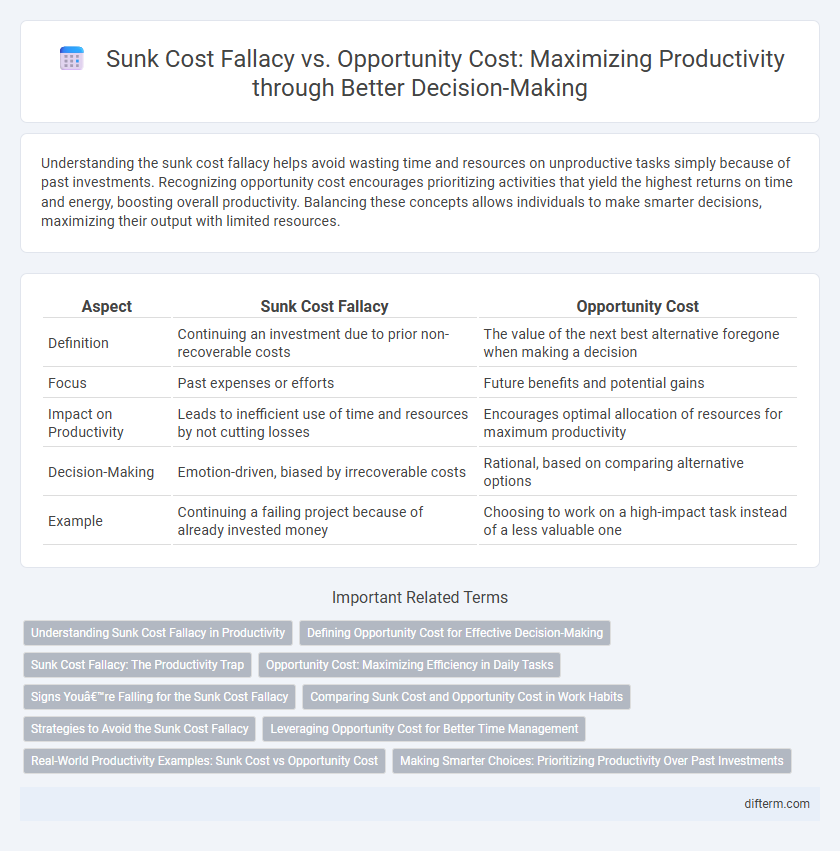Understanding the sunk cost fallacy helps avoid wasting time and resources on unproductive tasks simply because of past investments. Recognizing opportunity cost encourages prioritizing activities that yield the highest returns on time and energy, boosting overall productivity. Balancing these concepts allows individuals to make smarter decisions, maximizing their output with limited resources.
Table of Comparison
| Aspect | Sunk Cost Fallacy | Opportunity Cost |
|---|---|---|
| Definition | Continuing an investment due to prior non-recoverable costs | The value of the next best alternative foregone when making a decision |
| Focus | Past expenses or efforts | Future benefits and potential gains |
| Impact on Productivity | Leads to inefficient use of time and resources by not cutting losses | Encourages optimal allocation of resources for maximum productivity |
| Decision-Making | Emotion-driven, biased by irrecoverable costs | Rational, based on comparing alternative options |
| Example | Continuing a failing project because of already invested money | Choosing to work on a high-impact task instead of a less valuable one |
Understanding Sunk Cost Fallacy in Productivity
Understanding the sunk cost fallacy in productivity reveals how individuals irrationally continue investing time and resources in unproductive tasks due to prior commitments. Recognizing that sunk costs are irrecoverable helps shift focus toward opportunity costs--the potential gains from alternative activities. Prioritizing decisions based on future benefits rather than past investments maximizes efficiency and drives better productivity outcomes.
Defining Opportunity Cost for Effective Decision-Making
Opportunity cost represents the value of the next best alternative foregone when making a decision, guiding individuals and organizations to allocate resources efficiently. Unlike the sunk cost fallacy, which traps decision-makers into justifying past investments regardless of future benefits, understanding opportunity cost emphasizes future gains and potential trade-offs. Incorporating opportunity cost into decision-making frameworks enhances productivity by prioritizing actions with the highest return on time, effort, and capital.
Sunk Cost Fallacy: The Productivity Trap
The sunk cost fallacy traps productivity by compelling individuals to continue investing time and resources into unproductive tasks simply because of prior commitment, leading to diminishing returns. This psychological bias distracts from evaluating the true opportunity cost of diverting effort to more valuable activities. Overcoming the sunk cost fallacy enhances decision-making, freeing focus for higher-impact goals and optimizing overall productivity.
Opportunity Cost: Maximizing Efficiency in Daily Tasks
Opportunity cost emphasizes prioritizing tasks that yield the highest value to maximize efficiency in daily productivity. Evaluating potential gains from alternative activities helps avoid time wasted on low-impact efforts driven by sunk cost fallacy. Effective task management leverages opportunity cost to allocate resources and focus on activities with optimal returns.
Signs You’re Falling for the Sunk Cost Fallacy
Continuing to invest time or resources into a failing project despite clear evidence of diminishing returns is a key sign of the sunk cost fallacy. Holding onto past investments instead of evaluating potential future benefits leads to missed opportunities and reduced productivity. Recognizing this cognitive bias enables better decision-making by focusing on opportunity costs and maximizing output efficiency.
Comparing Sunk Cost and Opportunity Cost in Work Habits
Sunk cost fallacy causes individuals to continue investing time and resources into unproductive tasks due to past commitments, while opportunity cost emphasizes evaluating the potential benefits of alternative actions to maximize productivity. Recognizing opportunity cost helps prioritize tasks with the highest value return, whereas succumbing to sunk costs leads to inefficient work habits and wasted efforts. Balancing these concepts enables better decision-making by focusing on future gains rather than irrecoverable investments.
Strategies to Avoid the Sunk Cost Fallacy
To avoid the sunk cost fallacy and improve productivity, regularly evaluate ongoing projects based on future benefits rather than past investments. Implement decision-making frameworks that emphasize opportunity cost, ensuring resources are allocated to tasks with the highest potential returns. Establish clear exit criteria and encourage a culture where pivoting or terminating unproductive efforts is seen as a strategic advantage.
Leveraging Opportunity Cost for Better Time Management
Maximizing productivity requires recognizing the sunk cost fallacy, which traps individuals into investing time in unproductive tasks due to past investments. Leveraging opportunity cost shifts focus to evaluating alternative activities that yield higher returns for time spent. Prioritizing tasks based on opportunity cost fosters efficient time management, enabling better decision-making and resource allocation.
Real-World Productivity Examples: Sunk Cost vs Opportunity Cost
In productivity decisions, the sunk cost fallacy often traps individuals into continuing unproductive projects due to past investments, while opportunity cost highlights the potential gains foregone by not reallocating time or resources to more valuable tasks. For example, spending hours fixing a failing software feature because of previously invested development time ignores opportunities like creating new, innovative features that could drive growth. Businesses maximizing productivity assess opportunity costs to pivot resources efficiently rather than falling prey to sunk costs that waste time and reduce overall output.
Making Smarter Choices: Prioritizing Productivity Over Past Investments
Prioritizing productivity requires understanding the difference between sunk cost fallacy and opportunity cost to make smarter decisions. Sunk cost fallacy traps individuals into continuing unproductive efforts due to past investments, while opportunity cost emphasizes evaluating potential gains from alternative actions. Focusing on opportunity cost enables better resource allocation and higher efficiency by choosing options that maximize future productivity rather than clinging to irrecoverable past expenses.
Sunk cost fallacy vs Opportunity cost Infographic

 difterm.com
difterm.com